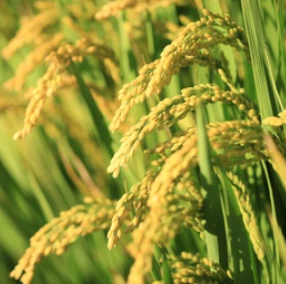Information report for OsGA20ox1;GNP1
Gene Details
|

|
Functional Descriptions
- Analysis of mRNA and the endogenous GAs reveal that biologically active GA level is increased by up-regulation of the OsGA20ox1 gene in B142.
- Within this mapped region, we identified the gene OsGA20ox1, which is related to gibberellin (GA) biosynthesis.
- Consistent with the dwarf phenotype of gd1, expression of the gibberelic acid (GA) inactivation gene OsGA2ox3 is increased dramatically, accompanied by reduced expression of GA biosynthetic genes including OsGA20ox1, OsGA20ox2 and OsGA3ox2 in gd1, resulting in a decreased endogenous GA(4) level.
- These results indicate that OsGA20ox1 is a strong candidate gene for major QTL controlling seedling vigor in rice.
- OsGA20ox1, a candidate gene for a major QTL controlling seedling vigor in rice.
- A role of OsGA20ox1 , encoding an isoform of gibberellin 20-oxidase, for regulation of plant stature in rice.
- The QTL GNP1 Encodes GA20ox1, Which Increases Grain Number and Yield by Increasing Cytokinin Activity in Rice Panicle Meristems.
- We propose that cytokinin activity increased due to a KNOX-mediated transcriptional feedback loop resulting from the higher GNP1 transcript levels, in turn leading to increased expression of the GA catabolism genes GA2oxs and reduced GA1 and GA3 accumulation.
- Sequence variations in its promoter region increased the levels of GNP1 transcripts, which were enriched in the apical regions of inflorescence meristems in NIL-GNP1TQ.
- The SDSFL1 mutant demonstrated some distinguished structural alterations, including shorter plant height and flag leaf length, increased tiller numbers and flag leaf width, and decreased panicle length compared with those of wild type (WT).
- The results thus offer a visible foundation for the molecular and physiological analysis of the SDSFL1 gene, which might participate in various functional pathways for controlling plant height and leaf length in rice breeding.
- Photosynthesis analysis showed that the photosynthetic rate (Pn), stomatal conductance (Gs), and intercellular CO2 concentration (Ci) were significantly increased in SDSFL1.
- Natural Sequence Variations and Combinations of GNP1 and NAL1 Determine the Grain Number per Panicle in Rice.
- Although the NAL1 and GNP1 genes regulating the rice GNP and grain yield have been cloned, their allelic diversity, functional differences in rice germplasms, and effects of their combination on GNP and grain yield remain unclear.
- Our results indicated that the GNP1 and NAL1 exhibited obvious differentiation and their combinations can significantly increase the grain yield in geng rice cultivars.
- These observations provide insights into the molecular basis of the GNP and may be useful for rice breeding of high yield potential by pyramiding GNP1 and NAL1.
- Pleiotropic Effect of GNP1 Underlying Grain Number per Panicle on Sink, Source and Flow in Rice.
- Our previous study indicated that the gene GNP1 encoding gibberellin biosynthesis gene GA20ox1 affects grain number per panicle (GNP) in rice, thus resulting in increase of grain yield.
- To clarify GNP1 effect on sink, source and flow in regulating rice grain yield, we compared Lemont, a japonica (geng) cultivar, with its near-isogenic line (NIL-GNP1 TQ) in Lemont background with introgression of the allele at GNP1 from Teqing, a high-yielding indica (xian) cultivar.
- Our results indicated that significantly increased GNP from introgression of GNP1 TQ into Lemont did not highly significantly improve grain yield of NIL-GNP1 TQ as expected, due primarily to significant low sink activities in IS and possible insufficient source supply which didn’t fully meet the increased sink capacity.
- Meanwhile, the expression of GA synthesis-related gene OsGA20ox1 was downregulated, whereas the expression of GA inactivation-related genes was upregulated in ipa1-NIL seeds.
- Further, the results demonstrated genomic and genetic evidence that the SV in the promoter of LTG1 is accounting for chilling sensitivity, and the increased copy numbers of GNP1 were associated with positive effects on grain number.
Functional Keywords
- ga , gibberellin , dwarf , seedling , panicle , grain , grain-number , yield , cytokinin , inflorescence , GA , leaf , tiller , photosynthesis , stomatal , breeding , height , plant-height , tiller-number , grain-yield , Gibberellin , gibberellin-biosynthesis , GA-inactivation , chilling
Literature and News
- OsGA20ox1, a candidate gene for a major QTL controlling seedling vigor in rice . DOI: 10.1007/s00122-012-1857-z ; PMID: 22481119
- A role of OsGA20ox1 , encoding an isoform of gibberellin 20-oxidase, for regulation of plant stature in rice . DOI: 10.1007/s11103-004-1692-y ; PMID: 15604710
- Altered disease development in the eui mutants and Eui overexpressors indicates that gibberellins negatively regulate rice basal disease resistance . DOI: 10.1093/mp/ssn021 ; PMID: 19825558
- The rice GERMINATION DEFECTIVE 1, encoding a B3 domain transcriptional repressor, regulates seed germination and seedling development by integrating GA and carbohydrate metabolism . DOI: 10.1111/tpj.12209 ; PMID: 23581288
- The QTL GNP1 Encodes GA20ox1, Which Increases Grain Number and Yield by Increasing Cytokinin Activity in Rice Panicle Meristems . DOI: 10.1371/journal.pgen.1006386 ; PMID: 27764111
- Rice SDSFL1 plays a critical role in the regulation of plant structure through the control of different phytohormones and altered cell structure . DOI: 10.1016/j.jplph.2018.09.005 ; PMID: 30253267
- Natural Sequence Variations and Combinations of GNP1 and NAL1 Determine the Grain Number per Panicle in Rice . DOI: 10.1186/s12284-020-00374-8 ; PMID: 32112146
- Pleiotropic Effect of GNP1 Underlying Grain Number per Panicle on Sink, Source and Flow in Rice . DOI: 10.3389/fpls.2020.00933 ; PMID: 32655609
- Gene Expression Dynamics in Rice Peduncles at the Heading Stage . DOI: 10.3389/fgene.2020.584678 ; PMID: 33343630
- IPA1 Negatively Regulates Early Rice Seedling Development by Interfering with Starch Metabolism via the GA and WRKY Pathways . DOI: 10.3390/ijms22126605 ; PMID: 34203082
- Time-ordering japonica/geng genomes analysis indicates the importance of large structural variants in rice breeding . DOI: 10.1111/pbi.13938 ; PMID: 36196761
Gene Resources
- UniProt: P93771
- EMBL: AC096690, AK099111, AP008209
- AlphaFoldDB: P93771
- EnsemblPlants: Os03t0856700-01, Os03t0856700-02
- Gramene: Os03t0856700-01, Os03t0856700-02
- KEGG: dosa:Os03g0856700, osa:4334841
- Orthologous matrix: SQFIWPA
- InterPro: IPR005123, IPR026992, IPR027443
Sequences
cDNA Sequence
- >LOC_Os03g63970.1
GATGCCGTGATCGATCGATCGATCTGTTGGCGCAGCGTGTATATAAGGGCGGGAAGGGGAGTGAGAGAGAGCAGCAGCTAGCTAGCCGCGGTCGGTCGATCCAGCTGCTGGGGATGAGTACTTAGTTAGCTCGGAGCTAGCTACTAATGGATGATATACTTATGCTAGTTAGTTAAATACAGTTATTAGTTAGTTGTAGGTTGCATCTATCATATCTCCATCGGTTAATTAATTGATTGATAGCTAGATTATCAACAATTAATGAGCATGGTGGTGCAGCAGGAGCAGGAGGTGGTGTTCGACGCGGCGGTGCTGAGCGGGCAGACGGAGATCCCGTCGCAGTTCATATGGCCGGCGGAGGAGAGCCCCGGGTCGGTGGCGGTGGAGGAGCTGGAGGTGGCGCTGATCGACGTGGGGGCGGGGGCGGAGAGGTCGTCGGTGGTCCGGCAGGTGGGGGAGGCGTGCGAGAGGCACGGCTTCTTCCTGGTGGTTAACCACGGCATCGAGGCGGCGCTGCTGGAGGAGGCGCACCGGTGCATGGACGCCTTCTTCACGCTGCCGCTGGGGGAGAAGCAGCGGGCGCAGCGGCGCGCGGGGGAGAGCTGCGGCTACGCCAGCAGCTTCACGGGGCGCTTCGCGTCCAAGCTGCCGTGGAAGGAGACGCTGTCGTTCCGGTACTCATCGGCTGGAGATGAAGAGGGCGAGGAGGGCGTGGGTGAGTACCTGGTGCGGAAGCTCGGGGCGGAGCACGGGCGGCGGCTGGGCGAGGTGTACTCGCGCTACTGCCACGAGATGAGCCGCCTGTCGCTGGAGCTGATGGAGGTGCTCGGGGAGAGCCTGGGCATCGTCGGAGACCGGCGCCACTACTTCCGGCGATTCTTCCAGCGCAACGACTCCATCATGCGCCTCAACTACTACCCGGCGTGCCAGAGGCCACTCGACACGCTGGGCACCGGTCCGCACTGCGACCCCACCTCGCTCACCATCCTCCACCAGGACCACGTCGGCGGCCTGGAGGTGTGGGCGGAGGGGCGGTGGCGCGCCATCCGCCCTCGCCCCGGGGCGCTCGTCGTCAACGTCGGCGACACCTTCATGGCGCTCTCCAACGCCAGGTACCGCAGCTGCCTGCACCGGGCGGTCGTCAACAGCACGGCGCCTCGCCGCTCGCTGGCCTTCTTCCTCTGCCCGGAGATGGACACGGTGGTGCGCCCGCCGGAGGAGCTGGTCGACGACCACCACCCGAGGGTGTACCCGGACTTCACGTGGCGGGCGCTGCTGGACTTCACGCAGCGCCACTACAGGGCCGACATGCGCACGCTTCAGGCCTTCTCCGACTGGCTTAATCATCATCGTCACCTGCAACCAACAATATACTCCTAGCTCCTAGTCCTAGCTATATACTCCTATTATCCATCCATCCATCCATCTTACACTACTATACCATTAGCATCGATCGATCATCCATTAATTAATTAATTAATTACTAGTTCCGGCTTAGATATATATCTGGCGATTATTTCAGTTCCTAGCTACTCCTACATGCATGCTTTGCTTAATTAGATCTATCTATCTAATCTATCCCGGCCGGCCTGTTTTAATTCCATATATCATTTGGTTTGCACGTACCCATCTATGATCTATATATACATGCATGTCGACTATTGTTGGTCGTACGATATTATATTATATATAGATGTAATACATATGTTGAAAATATATTGATTTCTTCTTGCTGTAGGAGTAATTAATTACTCCAGTTGTTGCTGTCACTCGATCAATCCATGGGATATGGGGATCGATCGGACGATATGCAGGAAGCTCAAGGACGATATGAATGATGCATGCATGTGTAAA
CDS Sequence
- >LOC_Os03g63970.1
ATGAGCATGGTGGTGCAGCAGGAGCAGGAGGTGGTGTTCGACGCGGCGGTGCTGAGCGGGCAGACGGAGATCCCGTCGCAGTTCATATGGCCGGCGGAGGAGAGCCCCGGGTCGGTGGCGGTGGAGGAGCTGGAGGTGGCGCTGATCGACGTGGGGGCGGGGGCGGAGAGGTCGTCGGTGGTCCGGCAGGTGGGGGAGGCGTGCGAGAGGCACGGCTTCTTCCTGGTGGTTAACCACGGCATCGAGGCGGCGCTGCTGGAGGAGGCGCACCGGTGCATGGACGCCTTCTTCACGCTGCCGCTGGGGGAGAAGCAGCGGGCGCAGCGGCGCGCGGGGGAGAGCTGCGGCTACGCCAGCAGCTTCACGGGGCGCTTCGCGTCCAAGCTGCCGTGGAAGGAGACGCTGTCGTTCCGGTACTCATCGGCTGGAGATGAAGAGGGCGAGGAGGGCGTGGGTGAGTACCTGGTGCGGAAGCTCGGGGCGGAGCACGGGCGGCGGCTGGGCGAGGTGTACTCGCGCTACTGCCACGAGATGAGCCGCCTGTCGCTGGAGCTGATGGAGGTGCTCGGGGAGAGCCTGGGCATCGTCGGAGACCGGCGCCACTACTTCCGGCGATTCTTCCAGCGCAACGACTCCATCATGCGCCTCAACTACTACCCGGCGTGCCAGAGGCCACTCGACACGCTGGGCACCGGTCCGCACTGCGACCCCACCTCGCTCACCATCCTCCACCAGGACCACGTCGGCGGCCTGGAGGTGTGGGCGGAGGGGCGGTGGCGCGCCATCCGCCCTCGCCCCGGGGCGCTCGTCGTCAACGTCGGCGACACCTTCATGGCGCTCTCCAACGCCAGGTACCGCAGCTGCCTGCACCGGGCGGTCGTCAACAGCACGGCGCCTCGCCGCTCGCTGGCCTTCTTCCTCTGCCCGGAGATGGACACGGTGGTGCGCCCGCCGGAGGAGCTGGTCGACGACCACCACCCGAGGGTGTACCCGGACTTCACGTGGCGGGCGCTGCTGGACTTCACGCAGCGCCACTACAGGGCCGACATGCGCACGCTTCAGGCCTTCTCCGACTGGCTTAATCATCATCGTCACCTGCAACCAACAATATACTCCTAG
Protein Sequence
- >LOC_Os03g63970.1
MSMVVQQEQEVVFDAAVLSGQTEIPSQFIWPAEESPGSVAVEELEVALIDVGAGAERSSVVRQVGEACERHGFFLVVNHGIEAALLEEAHRCMDAFFTLPLGEKQRAQRRAGESCGYASSFTGRFASKLPWKETLSFRYSSAGDEEGEEGVGEYLVRKLGAEHGRRLGEVYSRYCHEMSRLSLELMEVLGESLGIVGDRRHYFRRFFQRNDSIMRLNYYPACQRPLDTLGTGPHCDPTSLTILHQDHVGGLEVWAEGRWRAIRPRPGALVVNVGDTFMALSNARYRSCLHRAVVNSTAPRRSLAFFLCPEMDTVVRPPEELVDDHHPRVYPDFTWRALLDFTQRHYRADMRTLQAFSDWLNHHRHLQPTIYS*